Poisson’s equation#
As an example of a multi-dimensional boundary value problem, let’s try to solve Poisson’s equation
(or Laplace’s equation for \(\rho=0\)) with either \(V\) or \(\vec{\nabla} V\) specified on the boundary.
First we can finite-difference the equation. In 2D, with grid points labelled by \((i,j)\) this gives
where we set the grid spacing to \(h\) in both directions for simplicity. Collecting terms,
or
There are a few different ways we can try to solve this.
Relaxation: Jacobi and Gauss-Seidel#
Equation (11) shows that \(V_{i,j}\) is the average of \(V\) on the neighbouring grid cells plus an extra term from the charge density. This suggests a simple algorithm that we could use to relax to a solution from a starting guess:
There are two versions of this in which you either apply this rule to the whole grid, i.e use the values \(\{V^n\}\) on the right hand side to update all the grid points (Jacobi method) or you update one grid cell at a time and use the new values \(V^{n+1}_{i,j}\) on the right hand side when updating neighbouring cells (Gauss-Seidel method). The second method converges a factor of 2 faster (see the discussion in Numerical Recipes section 19.5).
As an example, let’s solve the 2D potential around a circular conductor, with \(V=1\) on the conductor and \(V=0\) at the boundaries. (We’ll take \(\rho=0\) so this is Laplace’s equation).
import numpy as np
from matplotlib import pyplot as plt
import time
def set_bcs(n):
# Create a mask to set the boundary points
# (following https://github.com/sievers/phys512-2022/tree/master/pdes )
mask = np.zeros([n,n],dtype='bool')
x = np.linspace(-1,1,n)
xsqr = np.outer(x**2,np.ones(n))
rsqr = xsqr+xsqr.T
R = 0.1
mask[rsqr<R**2] = True
mask[:,0] = True
mask[0,:] = True
mask[-1,:] = True
mask[:,-1] = True
bc = np.zeros([n,n])
bc[rsqr<R**2] = 1.0
return mask, bc
def laplace(mask, bc, niter, V, make_plot=True):
deltaV = np.zeros(niter)
t0 = time.time()
for i in range(niter):
Vnew = 0.25 * (np.roll(V,1,0) + np.roll(V,-1,0) +
np.roll(V,1,1) + np.roll(V,-1,1))
Vnew[mask] = bc[mask]
deltaV[i] = np.max(np.abs(Vnew-V))
V = Vnew
if i%1000 == 0 and make_plot:
n = len(V[0,:])
plt.plot(np.arange(n), V[n//2,:])
print('%d iterations took %lg seconds' %(niter, time.time()-t0))
return V, deltaV
# Solve Laplace's equation with Jacobi method
n = 128
mask, bc = set_bcs(n)
# Initial guess for the potential
V = np.zeros([n,n]) + 0.5
V[mask] = bc[mask]
plt.imshow(V)
plt.colorbar()
plt.show()
plt.clf()
plt.plot(np.arange(n), V[int(n/2),:], 'k--')
plt.ylabel(r'$V$')
plt.xlabel(r'$x$')
# The diffusion time across the grid is ~n^2 so scale the number of iterations accordingly
V_jacobi, deltaV_jacobi = laplace(mask, bc, 2*n*n, V)
plt.plot(np.arange(n), V_jacobi[int(n/2),:], 'k')
plt.show()
plt.clf()
plt.imshow(V_jacobi)
plt.colorbar()
plt.show()
plt.clf()
plt.plot([n**2/4,n**2/4], [min(deltaV_jacobi),max(deltaV_jacobi)], ':', label=r'$(n/2)^2$')
plt.plot(np.arange(len(deltaV_jacobi)), deltaV_jacobi)
plt.yscale('log')
plt.xscale('log')
plt.ylabel(r'max $\Delta V$')
plt.xlabel('Iteration')
plt.legend()
plt.show()
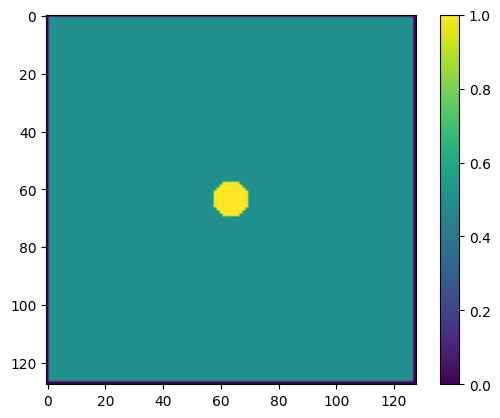
32768 iterations took 2.66838 seconds

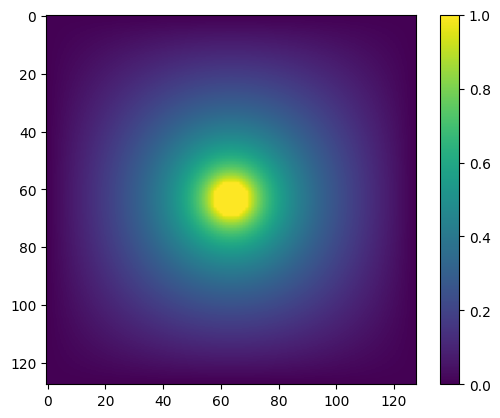
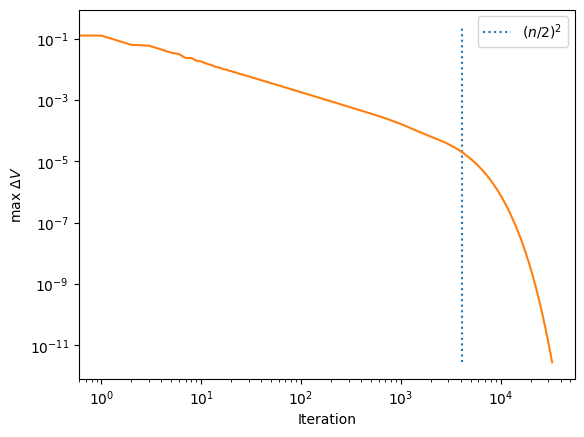
Notes
information propagates into the domain from the boundaries (at the center and the edges) where we specify the value of the potential
we can think of the successive iterations as evolving the system in time, in which case we are solving a diffusion equation (\(\partial/\partial t\propto \nabla^2\)). In a diffusion problem, the distance travelled is \(\propto \sqrt{t}\), or turning this around the time taken to travel a distance \(L\) is \(t\propto L^2\). In our case, we need the information from the boundaries to propagate across the grid, so we need to do a number of iterations \(\approx n^2\) to get a converged solution.
You can see the diffusion time across the grid appearing in the last plot where the solution converges rapidly after we’ve done \(\sim n^2\) iterations. (The vertical dashed line corresponds the diffusion time across half the box, ie. to number of iterations equal to \((n/2)^2\)).
if you run the code for a fixed number of iterations, you will find that the runtime scales \(\propto n^2\). However because the time taken to diffuse across the grid also scales \(\propto n^2\), the overall runtime increases \(\propto n^4\)! So this is a really slow method for large problems.
If you want to have some fun, try changing the boundary conditions, e.g. a plane-parallel capacitor:
def set_bcs_capacitor(n):
mask = np.zeros([n,n],dtype='bool')
x1 = 3*n//8
x2 = n-x1
mask[:, x2] = True
mask[:, x1] = True
bc = np.zeros([n,n])
bc[mask] = 1.0
mask[:,0] = True
mask[0,:] = True
mask[-1,:] = True
mask[:,-1] = True
return mask, bc
Multigrid method#
One way to try to speed up this kind of relaxation scheme is to use a set of grids with different resolutions. On a coarse grid with large spacing, the information from the boundaries can diffuse quickly across the whole grid. This information can then be passed down to successively finer spaced grids where the small scale structure is filled in. These methods are known as multigrid.
# Visualize matrices as a color map
def plot_matrices(A,titles=[],nmax=4):
n = len(A)
if titles==[]:
titles = [""]*n
if n>nmax:
nx = nmax
else:
nx = n
for j in range(int(np.floor(n/nmax))+1):
plt.clf()
plt.figure(figsize=(nx*4,4))
jmax = nmax*(j+1)
if jmax > n:
jmax = n
for i,AA in enumerate(A[nmax*j:jmax]):
plt.subplot(1, nx, i+1)
plt.imshow(AA)
plt.colorbar()
plt.title(titles[nmax*j + i])
plt.show()
We’re going to borrow two functions from last year’s course by Jon Sievers. These take in a matrix and return a matrix with either half the size (deres) or twice the size (upres). There are many ways to do this (typically you would use some kind of interpolation depending on the problem), here we downscale by replacing each set of 4 pixels by a single pixel with the maximum value of the 4, and we upscale by copying each pixel 4 times.
# A simple way to decrease or increase the number of grid points by a factor of 2
# From https://github.com/sievers/phys512-2022/tree/master/pdes
def deres(map):
tmp=np.maximum(map[::2,::2],map[1::2,::2])
tmp=np.maximum(tmp,map[::2,1::2])
tmp=np.maximum(tmp,map[1::2,1::2])
return tmp
def upres(map):
n=map.shape[0]
tmp=np.zeros([2*n,2*n])
tmp[::2,::2]=map
tmp[1::2,::2]=map
tmp[::2,1::2]=map
tmp[1::2,1::2]=map
return tmp
# Let's run a quick test of these functions
# Start with the initial condition from the Laplace problem above
# and deres a number of times
n = 256
mask, bc = set_bcs(n)
masks = [None] * 5
masks[0] = mask
for i in range(1,5):
masks[i] = deres(masks[i-1])
plot_matrices(masks, nmax=5)
<Figure size 640x480 with 0 Axes>

<Figure size 640x480 with 0 Axes>
<Figure size 2000x400 with 0 Axes>
# Solve Laplace's equation with a multigrid method
t0 = time.time()
n = 128
mask, bc = set_bcs(n)
# Initial guess for the potential
V0 = np.ones_like(bc) * 0.5
# First go down in resolution from fine to coarse
# and calculate the smoothed bc, mask and V arrays at each step
npass = 3
bcs = [bc,]
masks = [mask,]
Vs = [V0,]
for i in range(npass):
bcs.append(deres(bcs[i]))
masks.append(deres(masks[i]))
Vs.append(deres(Vs[i]))
# Now step back up, relaxing at each stage
for i in range(npass,0,-1):
n0 = bcs[i].shape[0]
Vs[i], deltaV = laplace(masks[i], bcs[i], 100, Vs[i], make_plot=False)
print('n = %d, Delta V = %lg' % (n0, deltaV[-1],))
Vs[i-1] = upres(Vs[i])
# Run the final grid for 2*n*n interations so that we can see how it converges
# now that the solution has been preconditioned
n0 = bcs[0].shape[0]
nn = 2*n0*n0
Vs[0], deltaV = laplace(masks[0], bcs[0], nn, Vs[0], make_plot=False)
print('n = %d, Delta V = %lg' % (n0, deltaV[-1],))
print('Total time taken = %lg seconds' % (time.time()-t0,))
titles = ["%d" % (V.shape[0],) for V in Vs]
plot_matrices(Vs[::-1], nmax = 2, titles=titles[::-1])
plt.clf()
plt.title(r'$V-V_{Jacobi}$')
plt.imshow(Vs[0]-V_jacobi)
plt.colorbar()
plt.show()
plt.clf()
plt.plot(np.arange(n), Vs[0][int(n/2),:], 'k')
plt.plot(np.arange(n), V_jacobi[int(n/2),:], ':')
plt.ylabel(r'$V$')
plt.xlabel(r'$x$')
plt.show()
plt.clf()
plt.plot(np.arange(len(deltaV)), deltaV)
plt.plot(np.arange(len(deltaV_jacobi)), deltaV_jacobi, ':')
plt.yscale('log')
plt.xscale('log')
plt.ylabel(r'max $\Delta V$')
plt.xlabel('Iteration')
plt.show()
100 iterations took 0.00239635 seconds
n = 16, Delta V = 0.000255252
100 iterations took 0.00291085 seconds
n = 32, Delta V = 0.00054352
100 iterations took 0.00392294 seconds
n = 64, Delta V = 0.000653078
32768 iterations took 3.0537 seconds
n = 128, Delta V = 5.16809e-14
Total time taken = 3.06391 seconds
<Figure size 640x480 with 0 Axes>
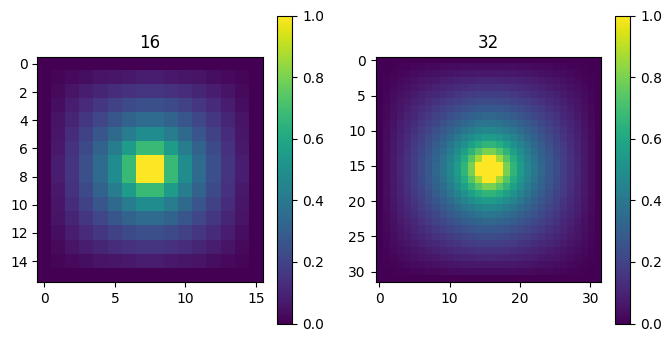
<Figure size 640x480 with 0 Axes>
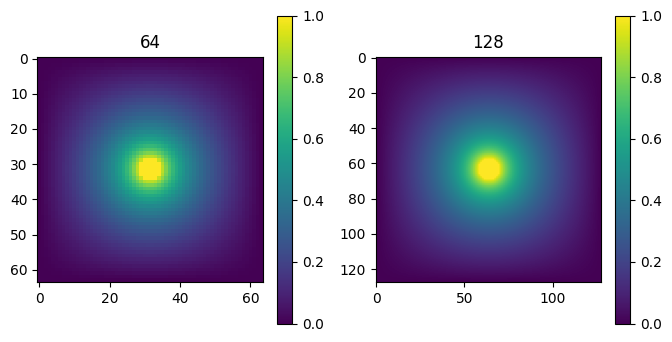
<Figure size 640x480 with 0 Axes>
<Figure size 800x400 with 0 Axes>
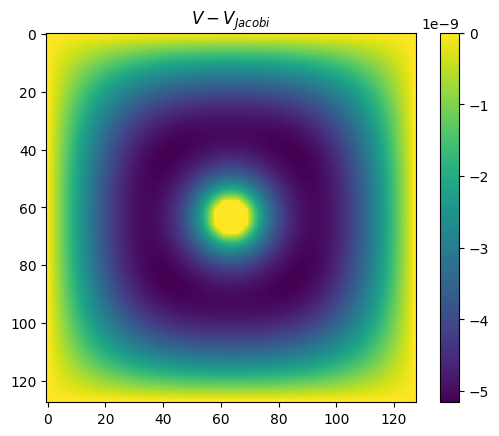
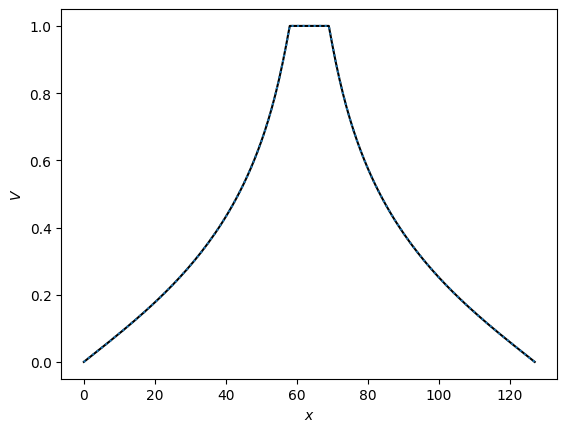
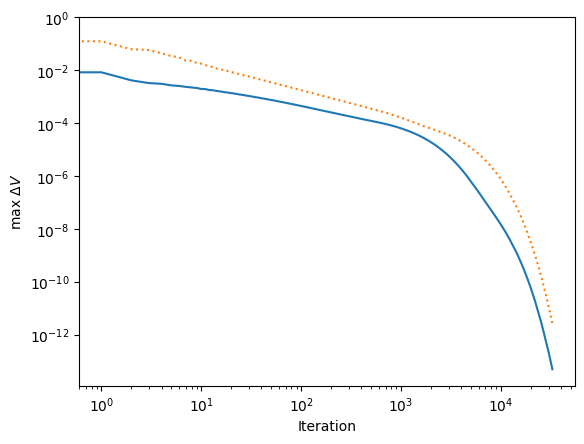
The last plot shows that this method converges much more quickly. In particular, we can now get a much more reasonable low-accuracy solution in the first part of the curve (number of iterations << n^2). Whereas previously these solutions were completely wrong because the diffusion from the boundaries had travelled only a small distance, now the coarse grids have taken care of the global diffusion and so the overall solution is much more accurate.
The general idea of using some approximate scheme to improve the initial guess for a relaxation method is known as preconditioning, and is used in many codes. Here, we can think of the sequence of low resolution grids as a preconditioner for the final relaxation at full resolution.
Further reading#
Good places to look for more detailed discussion of multigrid methods are Numerical Recipes 19.6 and in Mike Zingale’s course at Stonybrook.
